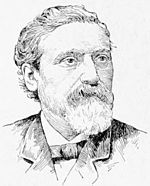Albert Fink
Albert Fink (born October 27, 1827 in Lauterbach (Hesse) ; † April 3, 1897 in Ossining , New York ) was a German-American civil engineer. He is known for designing railway bridges, where the fin girder (also used, for example, as a roof girder) is named after him.
Life
Fink studied civil engineering and architecture at the Polytechnic in Darmstadt, graduating in 1848. A year later he emigrated to the USA, where he became a draftsman and later assistant to chief engineer Benjamin Henry Latrobe, II at the Baltimore and Ohio Railroad, responsible for the Design and construction of buildings and bridges. He was instrumental in building the railway line from Cumberland, Maryland, to Wheeling, West Virginia , with some of the first iron bridges in the United States, such as the 1852 over the Monongahela River in Fairmont, West Virginia , then the longest iron railway bridge at 305 feet in the USA, realized with the Finkträger he invented.
He also oversaw the construction of many bridges and tunnels on the line between Grafton, Virginia and Parkersburg, West Virginia . At the same time he was involved as a consulting engineer in the construction of the railway bridge in Norfolk, Virginia for the Norfolk and Petersburg Railway . From 1857 he was assistant to the chief engineer of the Louisville and Nashville Railroad , George McLeod. There he was responsible for the construction of the Green River Bridge (1859) near Munfordville in Kentucky (at that time the longest iron bridge in the USA and only surpassed by the Victoria Bridge in Montreal in North America ), a bridge over the Cumberland River in Nashville (1866) and over the Ohio River in Louisville, Kentucky (1870, Fourteenth Street Bridge ), at that time the longest truss bridge with a length of one mile. It was also built with Finkträger. In 1860 he became a senior engineer on the Louisville and Nashville Railroad .
In the American Civil War many of its bridges were destroyed, and he spent the subsequent decade to rebuild.
In 1865 he became General Manager of the Louisville and Nashville Railroad and in 1869 its Vice President and General Superintendent . During this time the Verrugas Bridge in Peru was built with fin girders. In 1875 he retired and initially only wanted to work as a writer, but was then commissioned to set up the Southern Railway and Steamship Association in Atlanta , which was supposed to regulate the fierce competition among the approximately 25 railway companies there, for which a generally recognized personality was sought. In 1879/1880 he was its president. He managed to standardize and stabilize freight tariffs. When he came through New York City in 1877 (he wanted to visit Germany), he was commissioned by the four presidents of major railroad lines in New York (Vanderbilt, Jewett, Scott, Garrett) to mediate there as well. He founded the Trunk Line Association and became its director.
Fink is known as one of the first to carefully examine the real cost of rail transportation in the United States. The occasion was the financial crisis of 1873. He published the Fink report on transport costs (1874).
In 1878 he became president of the American Society of Civil Engineers (ASCE). In 1889 he finally retired (after the state regulation introduced with the Interstate Commerce Act in 1887, which made his mediation less urgent) and lived in Kentucky. He was married twice.
Web links
- Biography , according to Encyclopedia of World Biography
- Kelly, Haussman, Immigrant Entrpeneurship : Albert Fink
Individual evidence
- ^ Karl Gotsch: Fink Truss. Finkträger. In: Bridge Lexicon. Karl Gotsch, accessed on June 16, 2019 .
- ↑ It had Finkträger, a pillar was blown up by retreating southern troops during the civil war in 1861, but the bridge was provisionally rebuilt during the war. In 1898 the Finkträger were replaced and in 1926 the bridge was rebuilt again using the old pillars that are still in use today. Mike Page, The Greenriver Bridge at Munfordville , Bridge Hunter.
- ↑ Replaced in 1897 and no longer exists. She used Warren trusses, i.e. triangular girders between parallel belts. L&N - Cumberland River Triangular Truss , Bridge Hunter
| personal data | |
|---|---|
| SURNAME | Fink, Albert |
| BRIEF DESCRIPTION | American civil engineer |
| DATE OF BIRTH | October 27, 1827 |
| PLACE OF BIRTH | Lauterbach (Hesse) |
| DATE OF DEATH | April 3, 1897 |
| Place of death | Ossining |
